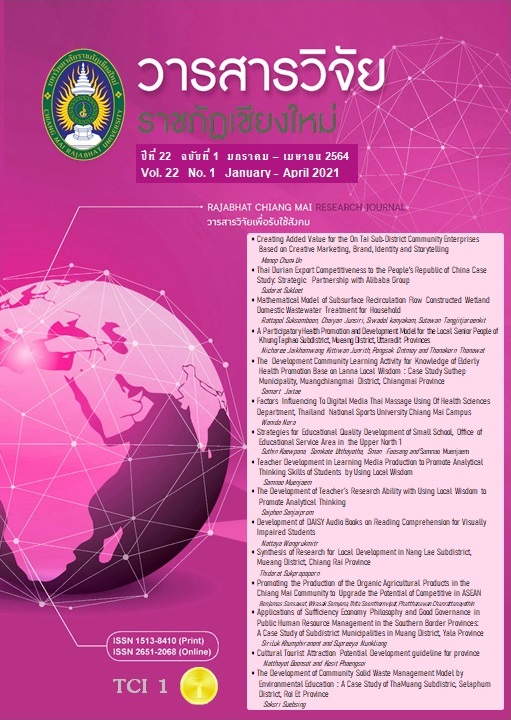Promoting the Production of the Organic Agricultural Products in the Chiang Mai Community to Upgrade the Potential of Competitive in ASEAN
DOI:
https://doi.org/10.14456/rcmrj.2021.241800Keywords:
Organic agriculture, Agricultural community, ASEANAbstract
The first objective of this research was to study the potential of the agricultural community in Chiang Mai. The second objective was further to research and creatively develop the agricultural sector based on the sufficiency economy with a promotion of organic agricultural production and its products in the community. The quantitative research was supported by quantitative analysis. The primary data was collected from three groups of farmers who participated voluntarily through local government organization. The survey research was questioned on three issues, namely, market leading: international organic standards, organic standard requirements and practices, and Participatory Guarantee System or PGS. The potential of organic production was analyzed with SWOT analysis and later discussed the statistical data using the average in the nature of descriptive statistics. This will be able to find ways to promote organic production in the community of Chiang Mai reaching a potential competition in the ASEAN. The research in the group of major agricultural producers, farmers in Chiang Mai showed an increase in the capacity of promoting the production of organic products in the community by 2.46%. The increase in three potential issues was a market leading of international organic standards by 3.44%, organic standard requirements and practices by 2.35%, and PGS by 1.59%. The next stage of research, the image of Lanna, should be expanded to seven other provinces due to a similarity of the urban context and the context of a group of farmers in Chiang Mai, Chiang Rai, Phayao, Phrae, Nan, Lampang, Lamphun and Mae Hong Son. This is a highly Lanna style of a wide variety of agricultural products. The Lanna perspective will be driving the research in further development the agricultural communities in Chiang Mai for commercial and public benefits. This includes the potential competition in the ASEAN region based on the philosophy of sufficient economy in a sufficient overview of Lanna agriculture.
Downloads
References
Chansilp, P. (2017). Summary report of meeting contents Organic Symposium 2017. Friday, July 28, 2017 at Ballroom, Queen Sirikit National Convention Center. (In Thai)
Economic base. (2013). Push organic farming, ASEAN hub. Thai Ching Share Global Market 1.8 million. Retrieved from http://ditp.go.th/contents_attach/74347/74347.pdf (In Thai)
Green Net. (2018). Thai organic agriculture 2017/18: leap, but will it stand firm or not. Retrieved from http://www.greennet.or.th/article/1979 (In Thai)
Green Net. (2020). Global organic agriculture continues to expand: production area increases 20%, market expands 12%. Retrieved from https://www.greennet.or.th/ Global organic agriculture continues (In Thai)
Jiampanyarach, W. (2017). Sustainable Impacts on Organic Farmers in Thailand: Lessons from Small-scale Farmers. Journal of Social Science, Srinakharinwirot University, 20 (1), 199-215. (In Thai)
Laoprasert, T. (2015). Tell both sides of the road Pushing Thai organic standards to rise to the world market. Retrieved from https://www.technologychaoban.com/news_detail.php?tnid=1942 (In Thai)
National Bureau of Agricultural Commodity and Cooperatives. (2012). Criteria for certification of organic agriculture. Retrieved from http://www.acfs.go.th/km/download/cer_sheme_organic.pdf (In Thai)
Office of the National Economic and Social Development Council (2020). Northern Development Plan 2017-2022 Review Edition. Retrieved from https://www.nesdc.go.th/ewt_dl_link.php?nid=8533 (In Thai)
RYT9.COM. (2020). Framework for Negotiation Agreement on Organic Agriculture Standards and ASEAN Certification Audit under the ASEAN Cabinet on Agriculture and Forestry. Retrieved from https://www.ryt9.com/s/cabt/3092023 (In Thai)
Sansawat, B. (2017). Promotion of organic agricultural production in the community of Chiang Mai. To have competitive potential in ASEAN. Office of the National Research Council. (In Thai)
Sansawat, B., & Sutthipasilp, P. (2019). Promoting the Production of Organic Products in Chiang Mai Province: the Potential Competition in ASEAN Community. Rajabhat Chiang Mai Research Journal, 20 (1), 20-29. (In Thai)
Downloads
Published
How to Cite
Issue
Section
License
1. Articles, information, content, images, etc published in the “Community and Social Development Journal” are copyrighted by the Community and Social Development Journal, Chiang Mai Rajabhat University. In order to properly distribute the articles through print and electronic media, the authors still hold the copyright for the published articles under the Creative Commons Attribution (CC BY) license, which allows the re-distribution of the articles in other sources. References must be made to the articles in the journal. The authors are responsible for requesting permission to reproduce copyrighted content from other sources.
2. The content of the articles appearing in the journal is the direct responsibility of the article authors. The editorial board of the journal does not necessarily agree with or share any responsibility.














